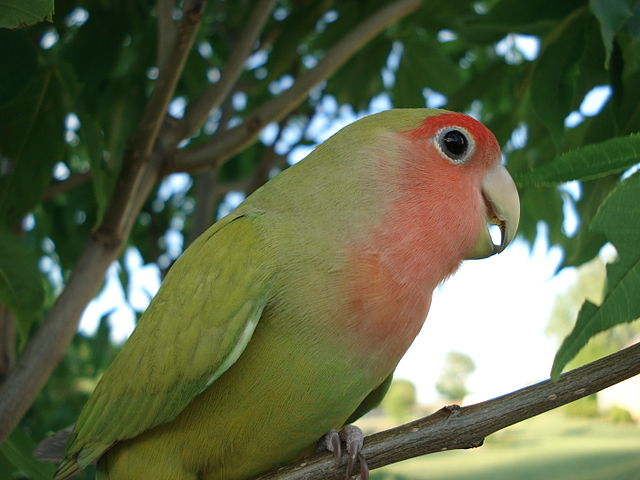Lovebird parrot climbs on three legs
When climbing vertically, a lovebird parrot has an extra leg at its disposal: its beak, according to research by Melody Young and colleagues.
Woodpeckers, nuthatches, treecreepers, parrots, and parakeets: all these birds are able to move up against a tree trunk. Woodpeckers, nuthatches, and treecreepers do so by hopping forward, both legs briefly releasing from the ground simultaneously. Parrots and parakeets do it differently. They clamber – using their beaks as a third leg, as Melody Young and colleagues show.
Everyone has observed parrots and parakeets using their beaks when climbing up. But do they really use their beak as a leg, or just for support and balance, in the same way as birds often use their tail? To find out, Young investigated the climbing skills of the rosy-faced lovebird, Agapornis roseicollis, a parrot from Southwest Africa.
Novel function
She brought six animals into the lab and let them walk across a runway at different inclinations. She filmed their gait with a high-speed camera and measured the force that legs, beak, and tail exerted on the substrate.
The lovebirds often used their beak and tail when walking if the runway was set up steeper than 45° inclination. If it was positioned vertically, beak and tail were always necessary. In that case, the beak functioned as an extra leg, as it turned out. The animals put both legs and beak forward in turn: right leg, left leg, beak, right leg, left leg, beak. Measured forces also showed that the beak plays a similar role as the legs in propulsion.
The tail helps support and balance the bird.
Parrots have given their beak a second function as an extra leg to climb with. The neck muscles must also have been adapted to this new task.
Willy van Strien
Photo: Rosy-faced lovebird. User Nbansal4732 of the English Wikipedia (Wikimedia Commons, Creative Commons CC BY-SA 2.5)
Source:
Melody W. Young, M.W., E. Dickinson, N.D. Flaim & M.C. Granatosky, 2022. Overcoming a ‘forbidden phenotype’: the parrot’s head supports, propels and powers tripedal locomotion. Proceedings of the Royal Society B 289: 20220245. Doi: 10.1098/rspb.2022.0245
